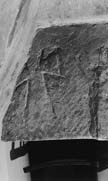Select a site alphabetically from the choices shown in the box below. Alternatively, browse sculptural examples using the Forward/Back buttons.
Chapters for this volume, along with copies of original in-text images, are available here.
Object type: Part of grave-cover
Measurements: L. > 36 cm ( > 14.2 in) W. > 35 cm ( > 13.8 in) D. 5 cm (2 in)
Stone type: Pale yellowish grey (10YR 8/2) oolitic limestone, with close-set ooliths and pellets of 0.3 to 0.5mm diameter in a calcite matrix. Upper Lincolnshire Limestone, Inferior Oolite Group
Plate numbers in printed volume: Ill. 87
Corpus volume reference: Vol 5 p. 127
(There may be more views or larger images available for this item. Click on the thumbnail image to view.)
A small broken fragment from a much larger monument. It has been cut down for reuse as a section of chevron moulding.
A (broad): Along one edge the remains of an undecorated border of rectangular section are clear and it appears that this border turned a corner to run along an original angle between faces A and B. Within the border on face A is a complete triquetra knot (Cramp 1991, fig. 25, Bi) in low relief; it is precisely cut and the interlace strand is decorated with an incised medial line. In one surviving corner of the face is a strand of an unconnected interlace motif which may have been no more than a space-filler in a corner left blank by the triquetra.
B (narrow): This face has been recut to be an element in a run of chevron moulding formed from a sequence of roll mouldings and fillets. It is badly damaged, though it clearly represents a recutting of the face.
C (broad): Defaced.
D (narrow): Within a similar undecorated border of rectangular section to that on face A is a faint trace of interlace, originally in low relief. A single box point is discernible.
E: The face adjacent to the undecorated border on A is plain.
See Carlby 2.



